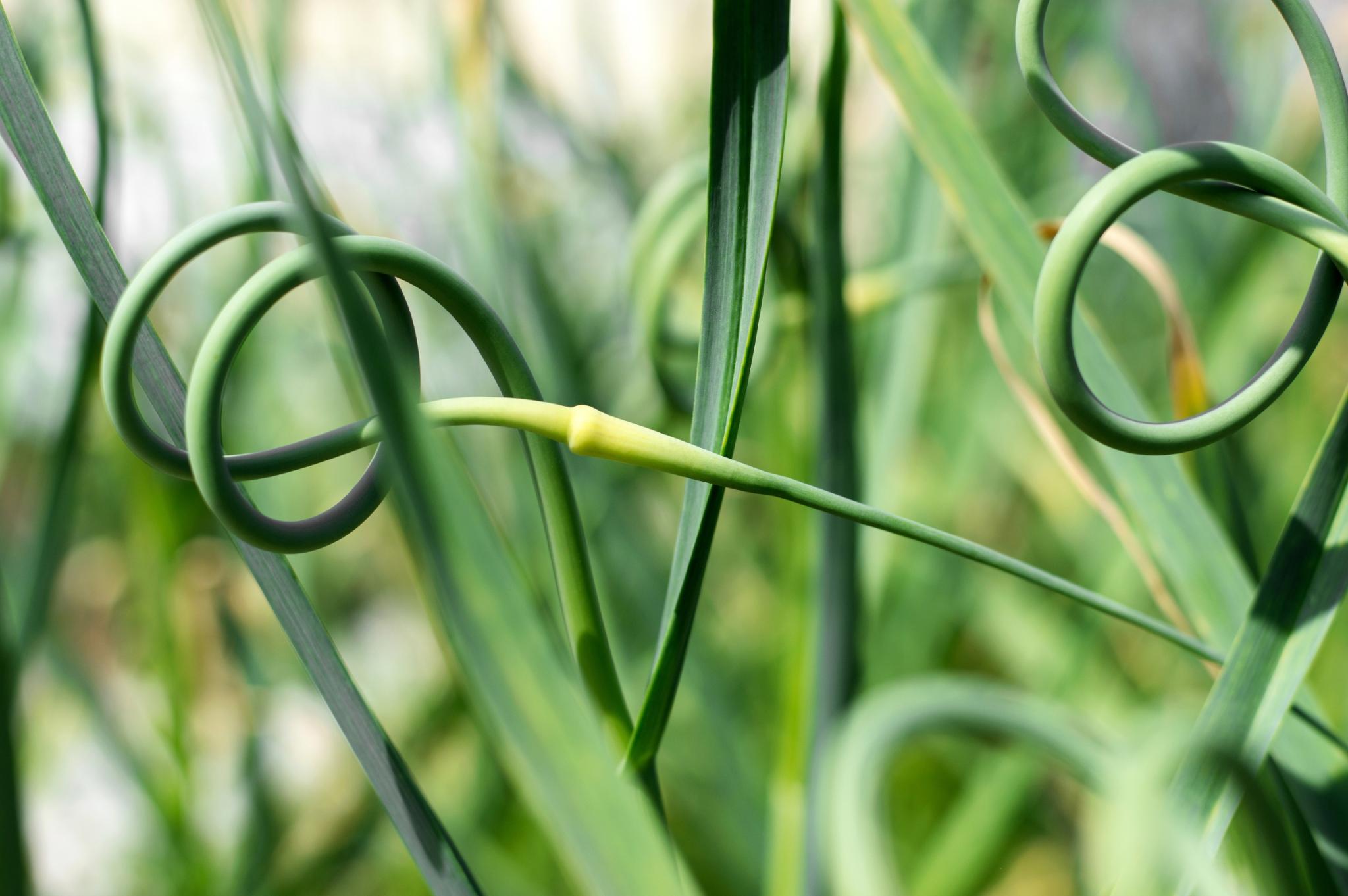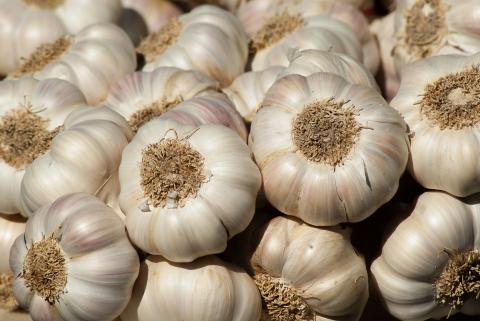Garlic is a pungent, nutrient-packed powerhouse that’s vital in countless recipes. It’s best planted in the fall in most areas. Learn how to plant, grow, and harvest garlic at home!
About Garlic
Garlic is surprisingly easy to grow, as long as you get the timing right. In addition to having an intense flavor and many culinary uses, the “stinking rose” also serves as an insect repellent in the garden, and it has been used as a home remedy for centuries.
Garlic does best in full sun, so select a planting site that receives 6 to 8 hours of sunlight per day.
A week or so before planting, prepare the soil by mixing in a healthy helping of compost or aged manure. Then, immediately before planting, work a couple tablespoons of 5-10-10 complete fertilizer, bonemeal, or fish meal into the soil several inches below where the base of the garlic cloves will rest.
If your garden soil is poorly draining or high in clay, garlic grower Robin Jarry of Hope, Maine, suggests growing in heavily mulched raised beds instead. “I plant in raised beds for good drainage, and then mulch with about 6 inches of old hay after the ground freezes. I never water my garlic—I like low-maintenance vegetables!”
Raised beds should be 2 to 3 feet wide and at least 10 to 12 inches deep.

Can You Plant Store-Bought Garlic?
While it is possible to grow garlic from store-bought bulbs, it’s not recommended.
Generally, the garlic found in grocery stores won’t grow well in home gardens and will yield small bulbs. This is because most commercial garlic comes from large-scale farming areas with mild climates (such as China or California), so the garlic may not be suited for growing in your own climate and may carry pests or diseases with it as well. Plus, if the garlic isn’t organic, it may have been treated with chemicals to inhibit sprouting.
You’ll see much more success by planting a variety of garlic that is specifically suited to your climate and growing season. (See Recommended Varieties, below). Look for the cloves (also called “seeds” or “sets”) of suitable varieties at local nurseries, farmers’ markets, or online seed suppliers.
When to Plant Garlic
Garlic is most often planted in the fall (between late September and November) and harvested in the following summer (between June and August). In areas that get a hard frost, plant garlic cloves 6 to 8 weeks before the first fall frost date, before the ground freezes.
Garlic does best if it can experience a “dormancy” period of colder weather—at least 40˚F (4°C)—that lasts 4 to 8 weeks. By planting garlic bulbs in the fall, they have time to develop healthy roots before temperatures drop and/or the ground freezes, but not enough time for the garlic to form top growth. Then, by early spring, the bulbs “wake up” from their dormancy and start rapidly producing foliage, followed by bulbs, before the harshest heat of summer stops their growth.
In mild climates, you can plant garlic cloves as late as February or March, but the resulting bulbs won’t be as large. However, you can still enjoy the garlic scapes during the summer. (Scapes are the plant’s tender green shoots and have a mild garlic flavor. Enjoy on eggs, in salads, as a pizza topping, or in stir-fries!) If you plant in the spring, wait to do so until after the soil can be worked and it crumbles apart easily.
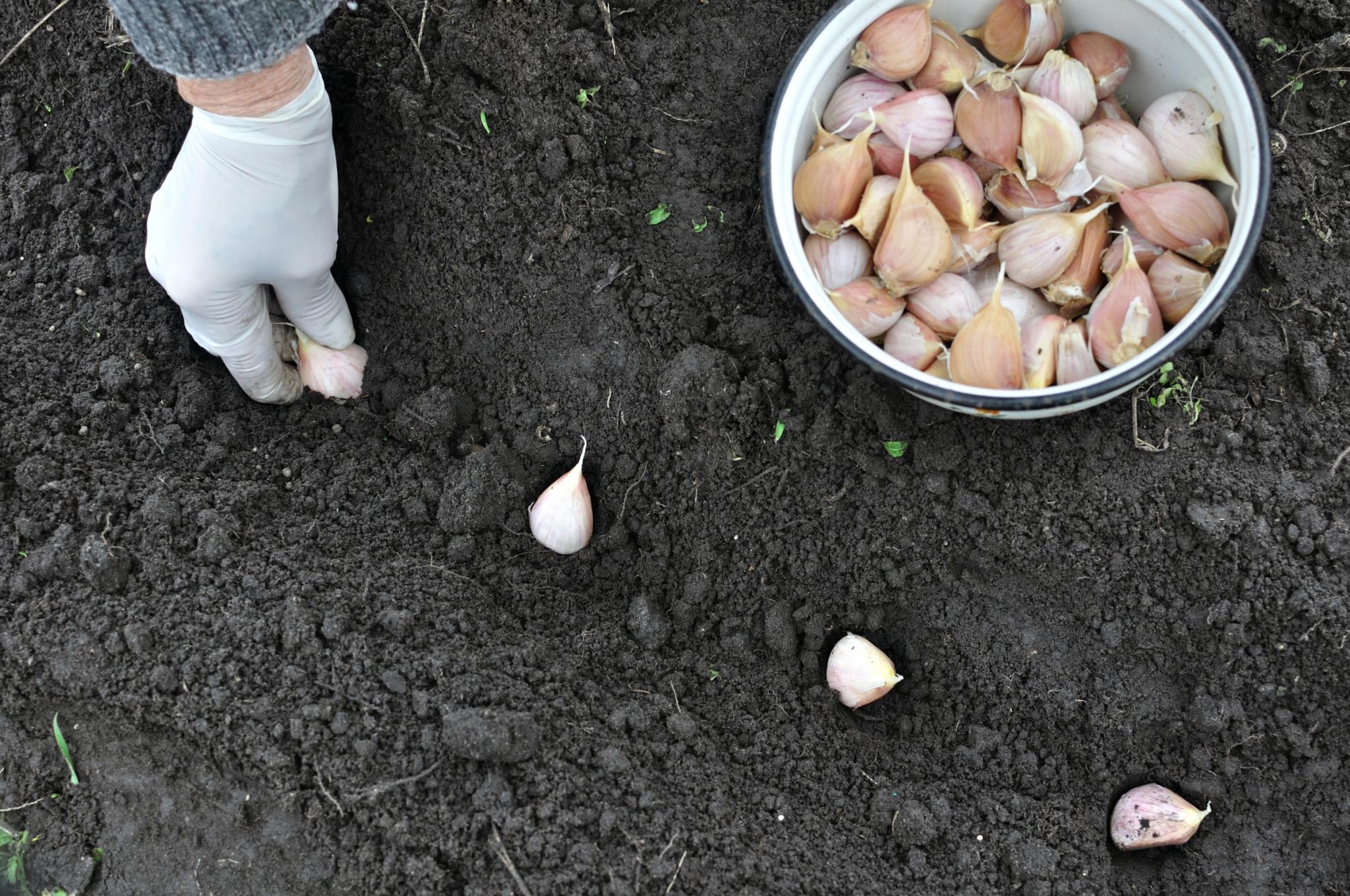
How to Plant Garlic
-
Select large, healthy cloves, free of disease. The larger the clove, the bigger and healthier the bulb you will get the following summer.
- Break apart cloves from the bulb a few days before planting, but keep the papery husk on each individual clove.
- Plant cloves 4 to 8 inches apart and 2 inches deep, in their upright position (with the wider root side facing down and pointed end facing up).
- Plant in rows spaced 6 to 12 inches apart. A single 10-foot row should yield about 5 pounds of the fragrant bulbs, depending on the variety.
→ See how we plant garlic in the fall.
In this short video, Ben shares his tried and tested techniques for planting a truly spectacular crop of garlic.
- Gardeners in areas where the ground freezes should mulch garlic beds heavily with straw or leaves to ensure proper overwintering. Read our mulching guide for more info!
- Mulch should be removed in the spring after the threat of frost has passed. (Young shoots can’t survive in temps below 20°F / -6°C on their own. Keep them under cover.)
- In the spring, as warmer temperatures arrive, shoots will emerge through the ground.
- Cut off any flower shoots that emerge in spring. These may decrease bulb size.
- Garlic is a heavy feeder. In early spring, side-dress with or broadcast blood meal, pelleted chicken manure, or a synthetic source of nitrogen such as a pelleted fertilizer.
- Fertilize again just before the bulbs begin to swell in response to lengthening daylight (usually early May in most regions). Repeat if the foliage begins to yellow.
- Keep the planting site well weeded. Garlic doesn’t do well with competition—it needs all available nutrients!
- Water every 3 to 5 days during bulbing (mid-May through June). If May and June are very dry, irrigate to a depth of 2 feet every eight to 10 days. As mid-June approaches, taper off watering.
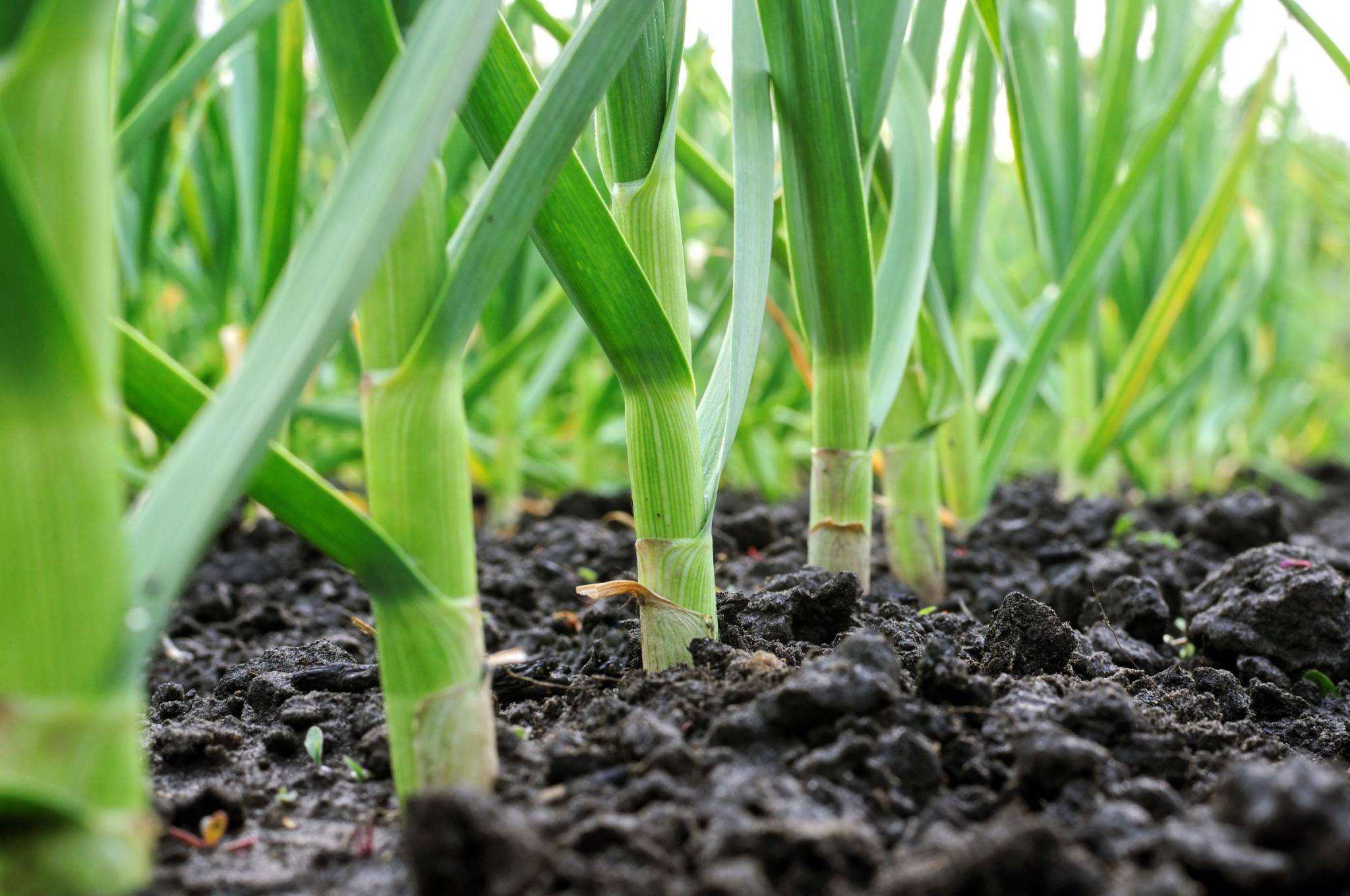
Garlic has very few problems with pests in the garden (in fact, it’s a natural pest repellent), and very few problems with the diseases that plague other veggies. Keep an eye out for the same pests that bother onions.
| Pest/Disease | Type | Symptoms | Control/Prevention |
|---|---|---|---|
| Onion maggots | Insect |
Limp, yellow, or stunted plants; larvae feed on roots/bulbs/stems and may spread bacteria |
Use row covers; harvest on a timely basis; monitor adults with yellow sticky traps; weed, especially wild onions; destroy crop residue; rotate crops |
| Onion thrips | Insect |
Leaves, especially in folds near base, have white patches or silver streaks; brown leaf tips; bulbs distorted or stunted; curling or scarring |
Remove plant debris; choose resistant varieties; add native plants to invite beneficial insects; use row covers; use straw mulch; monitor adults with yellow or white sticky traps; use sprinklers or other overhead watering |
| White rot | Fungus |
Leaves yellow, wilt, and die, starting with oldest; white, cottony growth at stem base or on bulb, later with black, poppy seed–like particles; roots rot |
Destroy infected plants; choose disease-free cloves/sets; destroy crop residue; disinfect tools; solarize soil; rotating crops on 5-year or longer cycle may help |
What type of garlic should you plant? There are two main types of garlic: Softneck and Hardneck.
- Hardneck varieties are extremely cold hardy so opt for these if your winters are harsh. They produce flower stems, aka “scapes,” which must be removed to encourage the bulbs to reach their full potential. The scapes themselves are an early summer treat, delicious if chopped into salads or added to stir-fries. Hardnecks grow one ring of fat cloves around a hard stem. While they are cold hardy, hardnecks do not store as well or as long as other varieties. Flavor is milder than softnecks, too. Common hardneck types include ‘Korean Red’, ‘Duganski’, ‘Siberian’, ‘Music’, ‘Chesnok Red’, ‘German Red’, ‘Purple Stripe’, and ‘Spanish Roja’.
- Softneck varieties, like their name suggests, have necks that stay soft after harvest, and therefore are the types that you’ll see braided together for storage. Softnecks are especially recommended for those in warmer climes, as they are less winter-hardy than other types. They have strong, intense flavor and tend to grow bigger bulbs because energy is not being diverted to top-set bulblets like hardnecks. Softneck varieties include ‘Silverskin’, ‘Inchelium Red’, ‘California Early’ and ‘Artichoke’.
While not a true garlic, the enormous Great-headed (Elephant) garlic behaves like a hardneck type. Despite its size, it has quite a mild flavor. Most types are about 90 days to harvest, once growth starts.
- Great-headed (Elephant) garlic is not recommended if you’re looking for a garlic taste. It’s less hardy, and more closely related to leeks than other varieties. The flavor is more like onion than traditional garlic. Bulbs and cloves are large, with about 4 cloves to a bulb.
See our complete video that demonstrates how to grow and how to harvest garlic!
- Harvest from fall plantings will range from late June to August. If you planted in the spring, calculate your approximate harvest date based on the “days to maturity” of the garlic variety you planted.
- In general, the clue is to look for yellowing foliage, but this isn’t the case for all garlic varieties. Harvest when the tops just begin to yellow and fall over, but before they are completely dry.
- Before digging up your whole crop, it’s a good idea to sample one bulb. Lift a bulb to see if the crop is ready. We often dig up a bulb before the tops are completely yellow (in late June or early July) as some garlic types will be ready earlier. The garlic head will be divided into plump cloves and the skin covering the outside of the bulbs will be thick, dry and papery.
- If pulled too early, the bulb wrapping will be thin and easily disintegrate.
- If left in the ground too long, the bulbs sometimes split apart. The skin may also split, which exposes the bulbs to disease and will affect their longevity in storage.
- To harvest, carefully dig (don’t pull or yank stems by hand) up the bulbs using a garden fork. Avoid damaging the roots and especially the root-plate (where they attach to the bulb). Lift the plants and carefully brush off surplus soil, but do not remove any foliage or roots before putting them to dry thoroughly.
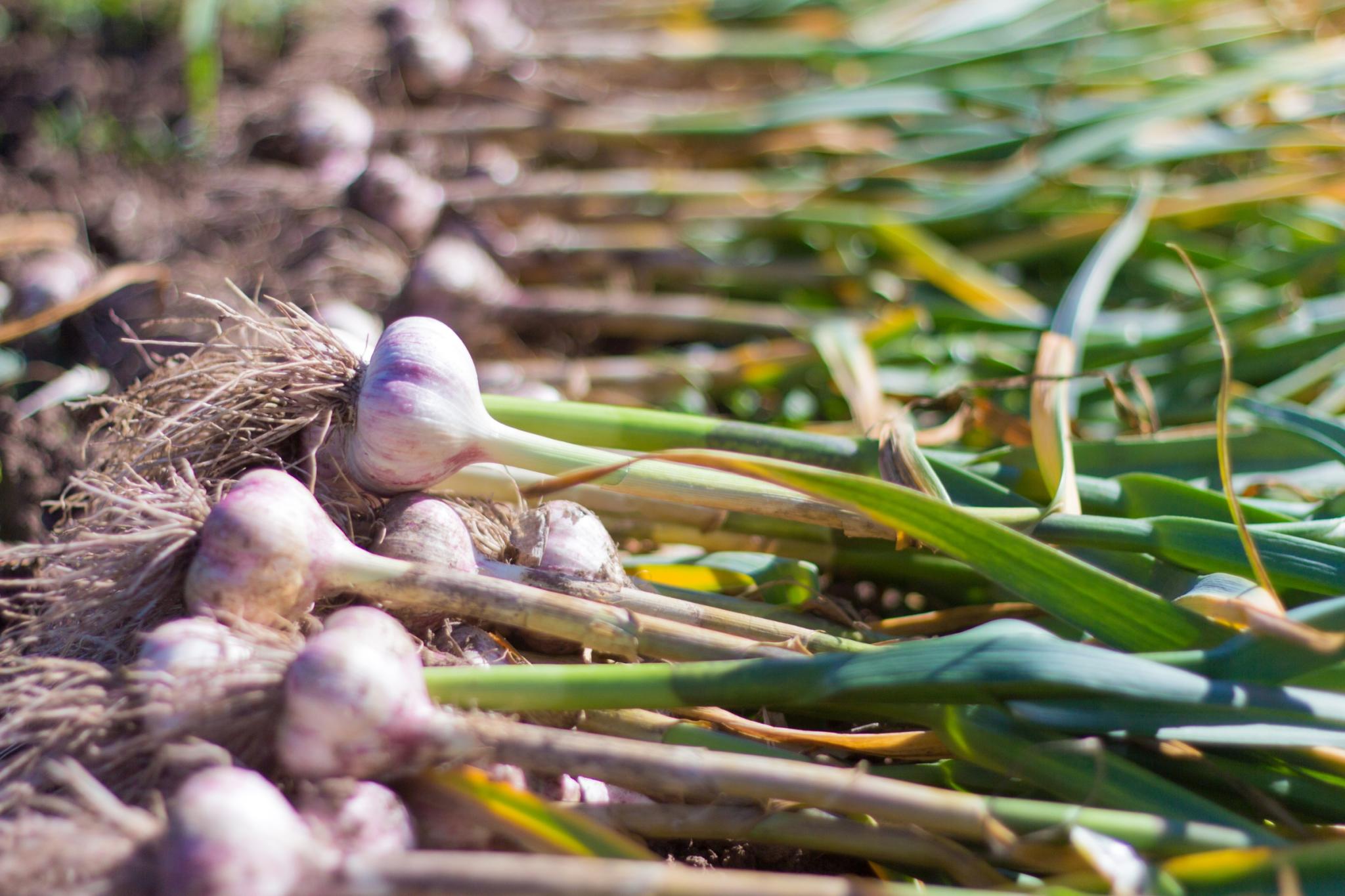
How to Store Garlic
- Let garlic cure in an airy, shady, dry spot for about 2 weeks. Hang them upside down on a string in bunches of 4 to 6 or leave them to try on a home-made rack made from chicken wire stretched over posts. Make sure all sides get good air circulation.
- After a few weeks, the garlic should be totally dry and ready to store.
- The bulbs are cured and ready to store when the wrappers are dry and papery and the roots are dry. The root crown should be hard, and the cloves can be cracked apart easily.
- Once the garlic bulbs are dry, you can store them. Brush off (do not wash) dirt, remove only the dirtiest wrappers, trim roots to ¼ of an inch, and cut tops to 1 to 2 inches.
- Bulbs should be stored in a cool (40°F / 4°C), dark, dry place, and can be kept in the same way for several months. Don’t store in your basement if it’s humid. Do not store garlic in the refrigerator, either.
- The flavor will increase as the bulbs are dried. Properly stored, garlic should last until the next crop is harvested the following summer.
- If you plan on planting garlic again next season, save some of your largest, best-formed bulbs to plant again in the fall.
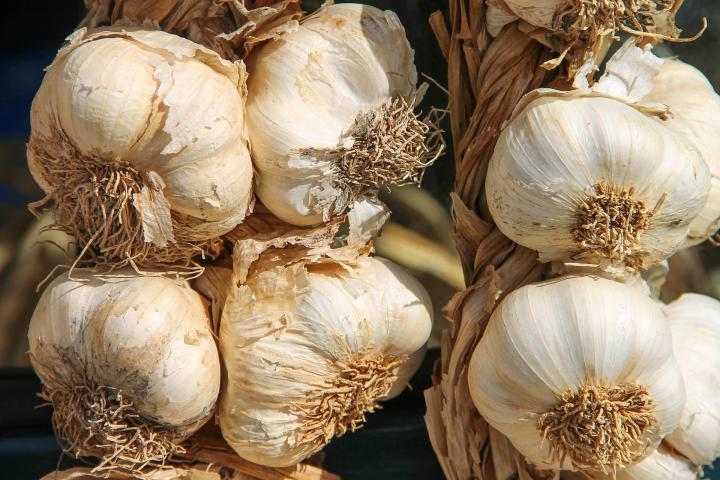
- Rub raw garlic on an insect bite to relieve the sting or itch. Find out more uses for raw garlic and more about garlic’s long history of healing.
-
Old-time gardeners swear that garlic “learns” because it adapts to your growing conditions and improves each year.
A nickel will get you on the subway, but garlic will get you a seat.
–Yiddish proverb
- Learn how to make your own garlic powder to easily spice up a recipe.
- Roasted garlic bulbs are also a favorite of ours!
- Around the time of the summer solstice (late June), hardneck garlic sends up a seed stalk, or scape. Allow it to curl, then cut off the curl to allow the plant to put its energy into bulb formation. Use the scapes in cooking the same way you would garlic bulbs. We like to stir fry scapes the way we cook green beans—similar, with a spicy kick! Note that they get more fibrous and less edible as they mature.
